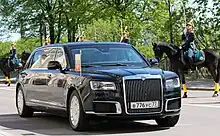NAMI (automotive institute)
The Central Scientific Research Automobile and Automotive Engines Institute, abbreviated as NAMI (Russian: Государственный научный центр Российской Федерации Федеральное государственное унитарное предприятие "Центра́льный нау́чно-иссле́довательский автомоби́льный и автомото́рный институ́т, romanized: Federal'noye gosudarstvennoye unitarnoye predpriyatiye "Tsentrál'nyy naúchno-isslédovatel'skiy avtomobíl'nyy i avtomotórnyy institút "НАМИ" (ГНЦ РФ ФГУП "НАМИ") is a scientific organization in Russia in the field of automotive industry development. The institute was awarded the Order of the Red Banner of Labour.[2]
 | |
| Formerly | Tractor Research Institution (1931–1946) |
|---|---|
| Type | Federal state unitary enterprise |
| Founded | 1918 |
| Headquarters | , Russia |
| Revenue | $32.3 million[1] (2017) |
| -$35.3 million[1] (2017) | |
| $352,143[1] (2017) | |
| Total assets | $293 million[1] (2017) |
| Total equity | $16.6 million[1] (2017) |
| Website | nami |

History
The research and development automobile and engine institute was established on 14 March 1920, based on the Scientific Automobile Laboratory (Russian: Научной автомобильной лаборатории (НАЛ)) of Scientific and Technical department of VSNKh, which was established on 16 October 1918. starting at 1924, the institute permitted purchases of foreign automobiles and automobile accessories. The first original automobile, the NAMI 1, was developed in 1927 (the first car of the USSR).
.jpg.webp)
During the 1930s the institute became the leading development department of the Soviet automotive industry. Following that year they developed and produced the first Soviet trolleybuses, and created tractor models and lorry models. For the Red Army half-tracks and armored vehicles had also been actively developed.
From 1931 to 1946 the institute bore the name Automobile and Tractor Research Institution (Russian: Научный автотракторный институт (НАТИ)).
At the beginning of 1946, because the tractor industry was transferred to be under the supervision of the Ministry of Agricultural Machinery, NATI was split in two. The automobile branch was kept under supervision of Ministry of Automobile Industry and was reorganized into Scientific and Research automobile and engine institute (NAMI) (Russian: Научно-исследовательский автомобильный и автомоторный институт (НАМИ)). The tractor division was transferred under the supervision of the Ministry of Agricultural Machinery. This division served as a basis for the Union Tractor Research Institution (NATI) (Russian: Научно-исследовательский тракторный институт (НАТИ)).
Multiple experimental and prototype engines were developed at the institute, many of which served as the basis for the mass production ones. In the 1960s the Institute developed some front-wheel drive and automatic transmissions which weren't put into production until much later, as these were deemed too expensive and complex for the current state of the industry, citing the example of a GAZ-21 automatic transmission, for which the service infrastructure was virtually non-existent.
Testing facility
In the 1960s the testing facility of NAMI (Russian: Научный испытательный центр автомобильной и мотоциклетной техники, НИЦИАМТ) was opened.
Prototypes
The only period of NAMI vehicle production was the 1920s and 1930s. Since then the NAMI vehicles are exclusively prototypes and concept cars.
|
|
References
- Error: Unable to display the reference properly. See the documentation for details.
- "ГОСУДАРСТВЕННЫЙ НАУЧНЫЙ ЦЕНТР РФ ФГУП «НАМИ»". iasf.nami.ru. Retrieved 8 September 2022.
- Прохоров продал права на «Ё-мобиль» за 1 евро Archived 12 April 2014 at the Wayback Machine
- Thompson, Mark (16 May 2022). "Renault sells Soviet-era icon Lada as it exits Russia, for now". Autocar. Retrieved 17 May 2022.